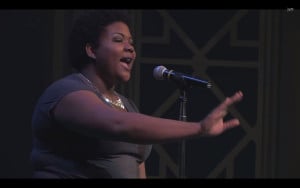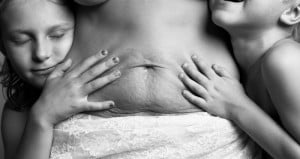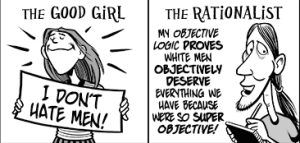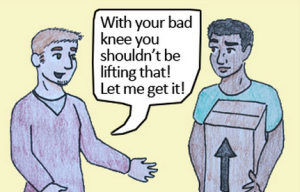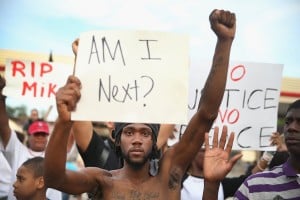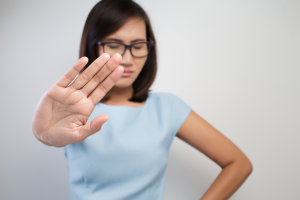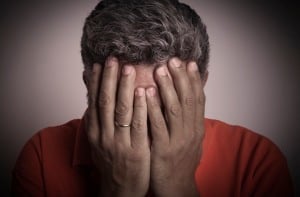
A close up of a person covering their face with their hands, ashamed. Source: Huffington Post
(Content warning: Jokes about abuse, violence, and rape)
The world can be a messed up place, hence the need for humor to take the edge off things. But is it appropriate that some forms of abuse are the butt of jokes more often than others?
For example, how many times have you heard jokes or comments like these?
- “Dressed like that, she must have been asking for it.”
- “Don’t drop the soap!”
- “Keep your pimp hand strong.”
The unfortunate truth is a lot of us have been conditioned to take some forms of abuse less seriously than others, due in part to stereotypes about culture, gender, and sexual orientation that circulate throughout the media.
Some forms of abuse that are routinely trivialized in everyday life include:
1. Domestic Abuse of Men
In the media, marriages in which men are henpecked by emotionally manipulative women are played for laughs. This YouTube video featuring abused black men cuddling stuffed animals in the arms of white women demonstrates our tendency to portray abuse against men in an exaggerated, humorous way.
According to the CDC’s 2010 National Intimate Partner and Sexual Violence Survey, about 1 in 4 men surveyed had experienced “rape, physical violence, and/or stalking by an intimate partner at some point in their lifetime” compared to about 1 in 3 women surveyed. Among gay men, 15% of gay men who participated in the National Violence Against Women Survey had been abused by a live-in partner.
So why aren’t we hearing more about this? The pressure placed on men to be stoic, strong, and in control of their intimate relationships makes male victims of domestic violence less likely to report the incident.
And given society’s dismissive attitude toward the seriousness of this type of abuse, men fear being shamed, ignored, and ridiculed by the very people they seek help from.
2. Rape of Men
Overlapping with the problem of intimate violence against men is rape of men by both other men and women. In addition to forced penetration of men, this includes incidents in which a man is forced to penetrate someone else. According to the CDC Survey cited above, this form of sexual abuse happened to 4.8% of men surveyed.
When it comes to getting support, justice, or visibility, male rape survivors are up against a slew of victim-blaming myths like, “He got it up, so he must have wanted it,” or “He could’ve fought the rapist off.”
In reality, men can have unwanted erections and be overpowered by their attackers. But the media continues to portray the myth that men enjoy even unwanted sex, as in the case of Lois raping Peter in an episode of Family Guy.
Also, statutory rape of young males is overlooked, with many people believing that sleeping with a teacher or older woman is a teen boy fantasy come true rather than a form of abuse.
3. Rape in Prison
One of the problems with rape jokes (and there are many) is that they tend to shame or blame the victim and validate the rapist. On The Boondocks, for example, there is an episode dedicated to a character called the Booty Warrior, a prisoner who seems to have nothing on his mind but raping other inmates.
When you consider that 4.5% of inmates surveyed by the Bureau of Justice Statistics reported sexual abuse in the past year, it’s clear that some prison staff are turning a blind eye to this type of abuse as well. And that number probably grossly underestimates the prevalence of prison rape.
Portraying rape as a form of justice, even jokingly, is f*cked up. I’m not suggesting that prison is meant to be Camp Sunshine by any means, but prison is already a punishment and rape is not the karmic due owed to criminals.
Furthermore, there are teenagers, petty criminals, and wrongly accused people receiving the same abuse in prison as hardened criminals—sexual abuse in prison can affect any inmate.
4. Sibling Abuse
Sibling rivalry is not uncommon, even in the healthiest families. Unfortunately, outright abuse between siblings gets confused with healthy sibling rivalry. The media normalizes abusive behaviors between siblings, such as the way Meg is treated by her siblings and other characters on Family Guy.
Sibling abuse goes beyond friendly roughhousing—it could involve battery, sexual molestation, rape, verbal abuse, psychological manipulation, or any other violence between siblings.
One worrying thing about sibling abuse is that parents might not take it seriously. Perhaps more worrying is that the inherent closeness between siblings may prevent victims of abuse from “telling on” their abusers.
Like other victims of domestic violence, people who have been abused by their siblings may keep quiet due to pressure from loved ones and fear of ridicule.
5. Violence Against People Facing Poverty
Poverty can lead to a heightened state of vulnerability to violence. From the senseless attacks and harassment directed toward homeless people to the bad relations between the justice system and poor communities, poor people are often targeted by those of higher income levels.
Since poor people are stereotyped in the media as having less education, intelligence, or character than people of higher income levels, people facing poverty in the real world get blamed for the violence in their communities.
Unfortunately, blatant disrespect for those facing poverty has become so normalized that abuse of actual homeless people, sometimes as cruel jokes, is on the rise. For example, Peter Rosello, the son of a Real Housewives reality star, was filmed punching a sleeping homeless man in the groin and running off.
6. Rape of Promiscuous Women
Slut-shaming and victim-blaming go hand in hand. Public opinion tends to assign more blame to victims of sexual assault who are sexually promiscuous, wear revealing clothing, or have sex shortly after the incident. For example, one UK woman’s case against a group of men that allegedly raped her was thrown out of court because she made online statements about group sex fantasies.
Some comedians reinforce this view of promiscuity by making jokes that shame victims of rape, like Daniel Tosh saying, “Beat it, slut! Go get raped on your own corner!” on Tosh.0.
But here’s the thing—rape is, by its very definition, unwanted. Women who own their sexuality never want to be raped. The way a woman adorns or enjoys her own body has nothing to do with whether or not another person decides to violate her bodily autonomy.
Just because a woman wanted to and did have sex many times before doesn’t mean she wants to have sex whenever someone approaches her. And when she doesn’t want to, it’s rape.
7. Pimping
Pimps who traffic women and children in prostitution have become the over-glorified butt of jokes as of late. Characters like A Pimp Named Slickback on The Boondocks backhand prostituted women as if it’s as funny as Jerry dropping an anvil on Tom’s head.
In real life, women and children in prostitution are frequent victims of abuse at the hands of both pimps and johns. One study reports that 78 percent of women in prostitution surveyed said they were raped an average of 16 times a year by pimps. The average age of entry for American girls into prostitution is 13 years old and guess who’s recruiting them – pimps.
In part because the ugly side of pimping is so minimized in our society, minors are seen as criminals at the state level and not as victims of child sexual abuse or statutory rape. Girls as young as 12 or 13 who are being manipulated and abused are regularly charged for the crimes their pimps are making them do.
Other forms of violence often utilized by pimps to exploit and control prostituted women and children include isolating them, minimizing their abuse, verbal abuse, intimidation, harassment, and battering. Pimps usually take all of their money and have nightly quotas that women have to earn or face violent repercussions. Some pimps even “brand” those they’re trafficking with tattoos of their name to demonstrate ownership. In other words, pimps do more harm than slapstick smacks across the face – and even that isn’t something to be laughed about.
***
To be clear, this is not an exhaustive list of every type of violence that gets minimized on a regular basis, nor is it part of any Feminist War on Humor (starting to think people believe this exists).
It’s just a reminder that a lot of the things we’ve been socially conditioned to make light of affect real survivors who are being shamed, stigmatized, and silenced by so called “jokes” about the abuse they’ve faced.
Every joke that validates abusers and shames victims, portrays victims as deserving of abuse or contributes to the stigma faced by survivors of abuse contributes to a social atmosphere that ignores the problems being laughed about.
As a society, we never want to burden ourselves by taking things too seriously. But that doesn’t justify taking abuses so lightly that we let them get worse.
[do_widget id=‘text-101′]
Jarune Uwujaren is a Contributing Writer for Everyday Feminism. A Nigerian-American recent graduate who’s stumbling towards a career in writing, Jarune can currently be found drifting around the DC metro area with a phone or a laptop nearby. When not writing for fun or profit, Jarune enjoys food, fresh air, good books, drawing, poetry, and sci-fi. Read their articles here.
Search our 3000+ articles!
Read our articles about:
Our online racial justice training
Used by hundreds of universities, non-profits, and businesses.
Click to learn more








